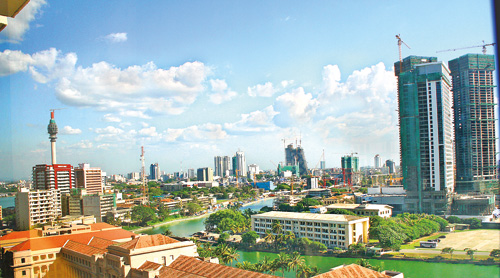News
Disasters ‘waiting to happen’ in mushrooming high-rises
Fears have risen over safety compliance in high-rise buildings following the recent tragic elevator crash, with concerns spreading to whether inadequate firefighting ability for tall buildings have made them fire traps.

Colombo's cityscape
In Colombo, where 90 per cent of the buildings are residential apartments accommodating families, questions are being raised about elevator safety as investigations continue into why a lift plunged down one floor on December 29, injuring two people and crushing to death a man who tried to jump out of the lift.
Reports said that the 30-year-old elevator at the Green Lanka tower building failed due to a lack of maintenance. Theories are also rife that the lift gave way under the weight it was carrying as too many (12) people had got in.
Construction bodies are also concerned about firefighting capacity in case of a major fire in apartment blocks.
Chamber of Construction Industry Secretary Col. Nissanaka Wijeratne said the mushrooming buildings in greater Colombo were “a disaster waiting to happen”.
“Our firefighters are not sufficiently equipped to fight a major fire,” he said, stressing the need to have aerial equipment and trained personnel to cope with conflagrations that could break out in high-rise buildings.
Major Constructors of Sri Lanka, an association of leading construction companies, agreed that Sri Lanka’s fire-fighting capacity is weak.
The body’s CEO, Brigadier Madura Wijewickrema, said it was necessary to have an outstanding capacity to fight massive fires in tall buildings.
“Our Sri Lanka Air force has no specialised helicopters for fighting massive fires,” he said.
In Colombo and its suburbs, the Urban Development Authority insists that all buildings higher than 10 storeys or 30m have a sprinkler system to prevent fires and that buildings above four storeys have a backup generator.
The Colombo Fire Brigade defended its capacity, saying its fire-fighting processes were updated in collaboration with the government’s construction industry regulator, the Construction Industry Development Authority (CIDA).
Chief Fire Officer P.D.K.A. Wilson said his brigade was equipped to fight fires in buildings up to 14 floors in height. Thereafter, he said, firefighters used elevator shafts to get to higher storeys.
He said every building plan had to be sent to the Firefighting Department for approval in keeping with fire safety regulations. On completion of construction, the officials of the department carried out checks for compliance.
CIDA said there was no direct regulation governing the safety of buildings once construction was completed and Certification of Completion obtained from local authorities.
CIDA Director Savindra Amarasekera said responsibility for building safety lay with the Condominium Management Authority (CMA) in the Ministry of Housing and Construction.
CMA President Christopher Wijeweera said building owners should ensure that proper installation mechanisms were in place in relation to electricity, water, elevators and water-proof rooftops before an application was made for Certification of Completion from the local authorities such as the Urban Development Authority (UDA).
Mr. Wijeweera said the onus to maintain lifts lay completely with the owner of the building who had to sign a maintenance agreement with the relevant elevator company once a building’s construction was completed.
UDA Chairman Jagath Munasinghe said the authority relied on certification issued by construction professionals. Contractors were expected to comply with specific standards in quality and installation. The UDA went along with professional certification that these standards had been upheld.
Thereafter, he said, building developers had to enter into service agreements for maintenance of building infrastructure. He said usually, after a guarantee period, such agreements were renewed annually.
“In the hotel trade, high-rise buildings are checked when they renew the licences. In apartment blocks this does not happen: a public authority needs to check this,” Mr. Munasinghe said.
Following the fatality caused by the crash of the lift at the Green Lanka tower block tenants in high-rise apartment blocks fear that safety checks are not universally observed.
One concerned tenant said that in the race to build taller buildings the maintenance factor was being ignored.
He also stressed the importance of having a lift operator for those who cannot operate elevators due to unfamiliarity, illiteracy or disability.
“The accident at Green Lanka Tower building could have been avoided if there was an operator in the lift who would not have allowed overloading,” he said.

